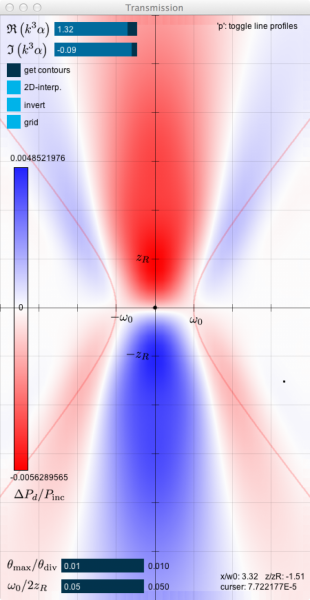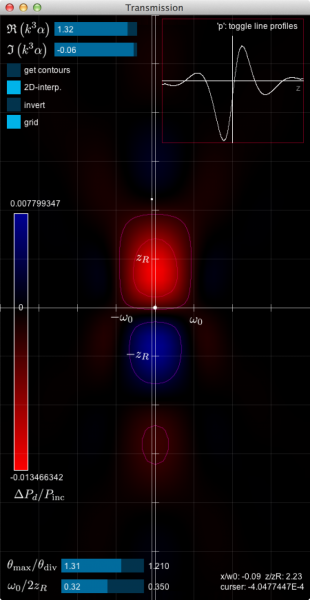The theoretical work upon which this code is based is published as “Energy Redistribution Signatures in Transmission Microscopy of Rayleigh- and Mie-Particles“, M. Selmke, F. Cichos, J. Opt. Soc. Am. A 31, 2370–2384 (2014).
This processing script (or the compiled application for MAC OS) visualizes the predictions of the generalized Lorenz–Mie theory concerning the relative transmission signal ΔP(x,z)/P in a scanning sample microscopy setup for a small Rayleigh particle (M. Selmke). Herein, x and z denote the lateral and axial offset of the particle relative to the incident Gaussian beam’s focus. Small means that the size-parameter x = kR should be smaller than about λ/20.
 The complex-valued polarizability of the nanoparticle determines the transmission signal in combination with two setup-parameters: The focusing parameter s (the ratio of the beam waist to the Rayleigh-range) and the ratio of the collection angle to the beam’s angle of divergence (θ_max/(2s)).
The complex-valued polarizability of the nanoparticle determines the transmission signal in combination with two setup-parameters: The focusing parameter s (the ratio of the beam waist to the Rayleigh-range) and the ratio of the collection angle to the beam’s angle of divergence (θ_max/(2s)).
The application uses 48 pre-computed dats-sets of 21×31 pixels (x/w0 = 0..4, z/2zR = 0…3) for selected combinations of setup-parameters (10 collection angle ratios: {0.01, 0.21, 0.41, 0.61, 0.81, 1.01, 1.21, 1.41, 1.61, 1.81} and 11 focusing parameters: {0.05, 0.075, 0.1, 0.125, 0.15, 0.175, 0.2, 0.225, 0.25, 0.275, 0.3}) using n = 150 multipoles. The complex-valued polarizability α = Re(α) – i Im(α) changes their relative weight. The exact polarizability may be obtained from the first Mie coefficient, while the value corresponding to a radiative reaction corrected Clausius–Mosotti polarizability provides an easily computed approximate expression.
The relative transmission signal is the change in collected transmission normalized to the background. It may be either positive (blue), indicating an enhanced transmission due to the corresponding placement of the Rayleigh-particle in the focal region, or the signal may be negative (red), indicating a reduced / diminished transmission for that position.
- Large negative imaginary parts of the particle’s polarizability α result in a large absorption and therefore in an enhanced weighting of a dip-like and negative component. This component grows and saturates when the collection angle exceeds the beams angle of divergence (the collection angle ratio becomes larger than 1).
- Large positive real parts of the particle’s polarizability α result in a dispersive signal shape, indicating the energy-redistribution. Also, for large collection angles this component disappears in magnitude. The scattering contribution which would then dominate (for small but non-negligible x) is neglected here. The neglect is justified for x < 0.1 up to collection angle ratios of about 2.
The 2D-bilinear interpolation (http://en.wikipedia.org/wiki/Bilinear_interpolation) of the used datasets is the default. In this setting, contours may be displayed statically, i.e. by pressing “Do Contours”.
If the 2D-bilinear interpolation may be turned off to display the original data, i.e. the spatial sampling of the data set of Ax.
For the proccessing source code only: The script requires an installation of the blobDetection library and the ControlP5 library.
Program shortcuts:
- “b”: draw beam-waist on/off
- “g”: grid on/off
- “x”: plot x-axis and z-axis on/off
- “i”: 2D-interpolate on/off
- “p”: switch through profile mode (x,z,none)
download processing script: Transmission
download MacOS application (compiled): Transmission.app


